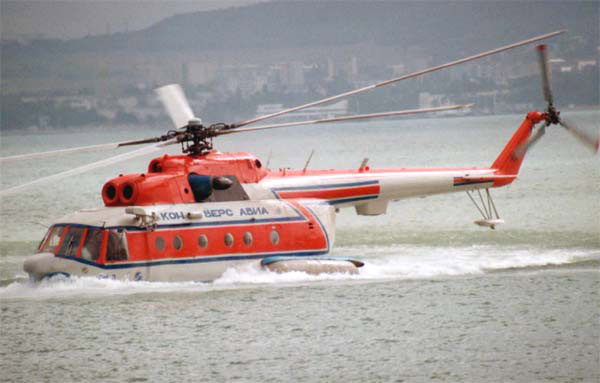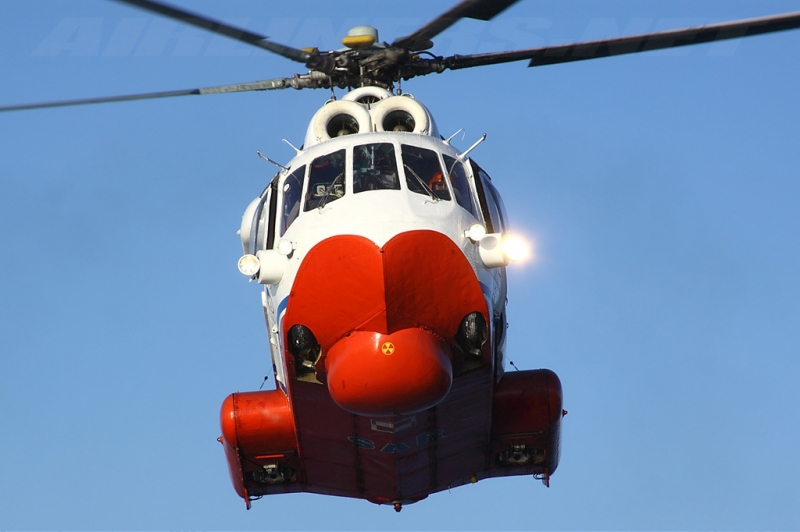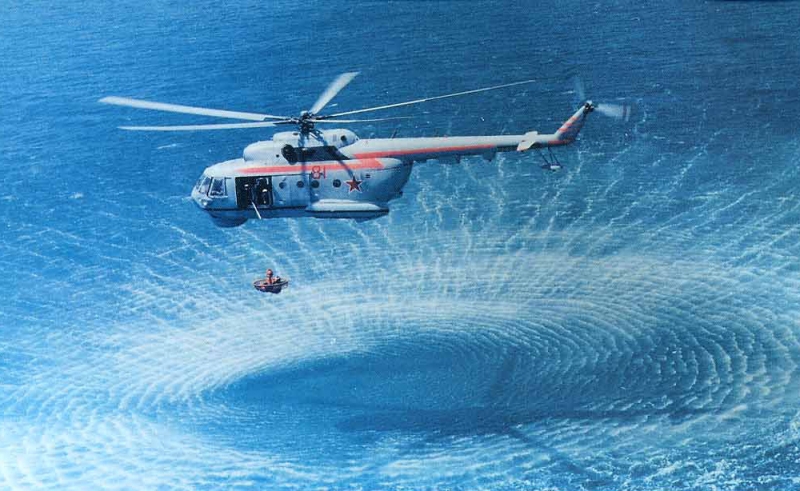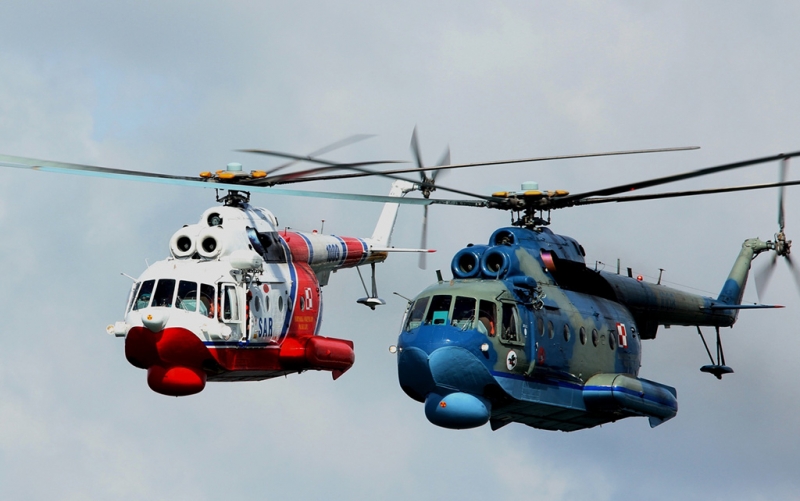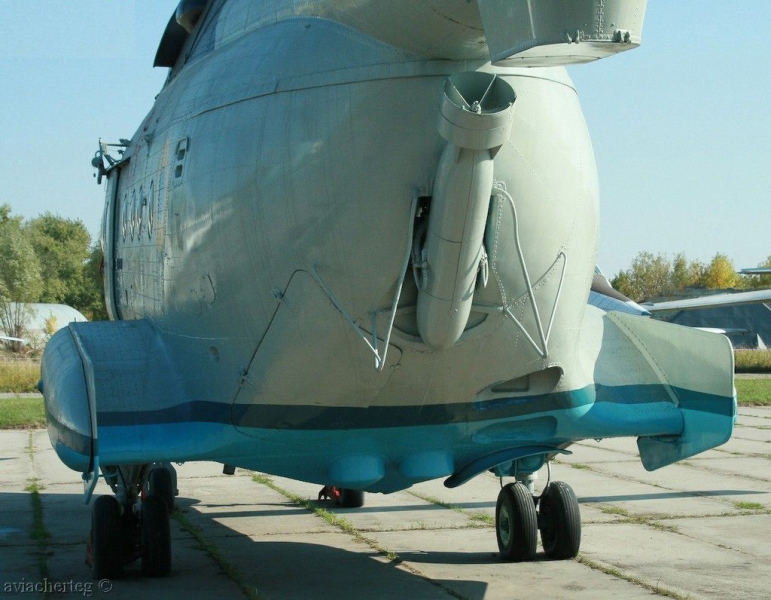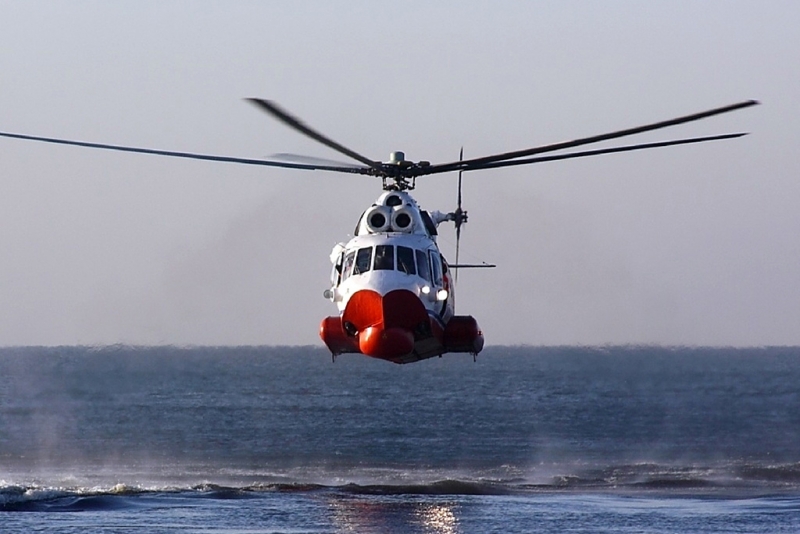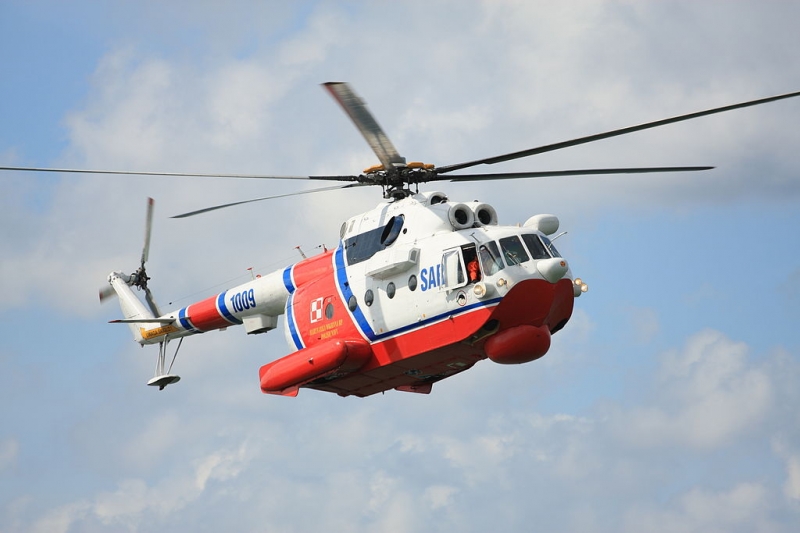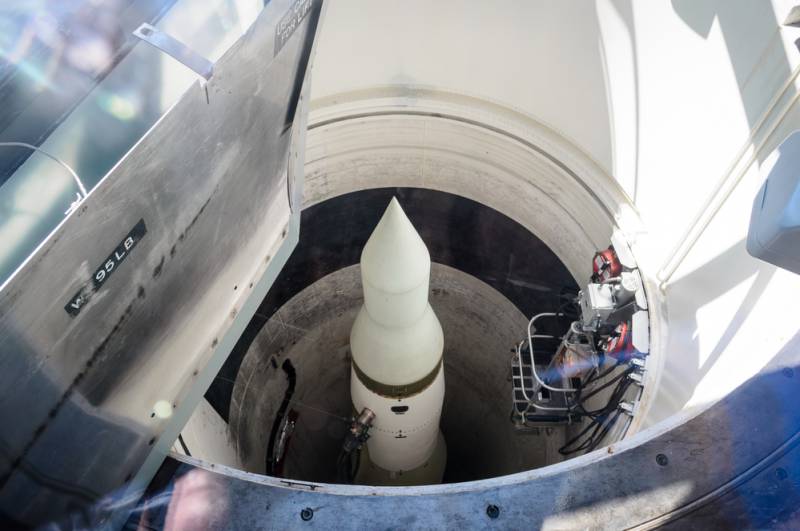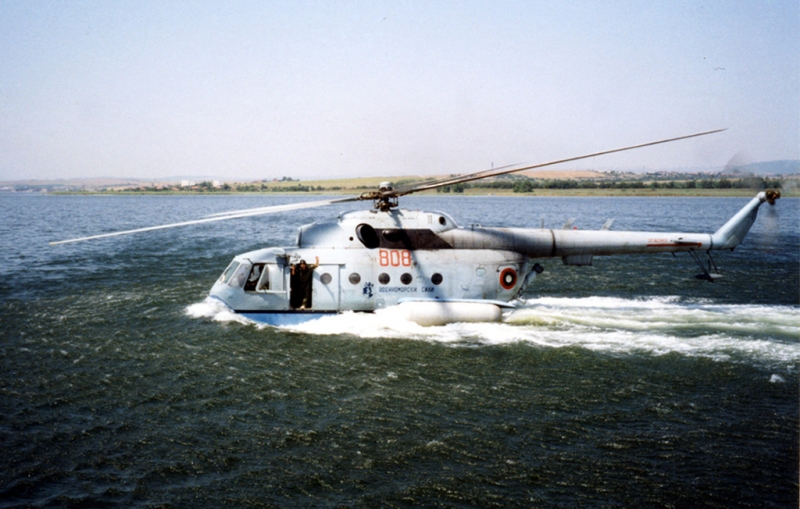
The Mi-14 has been developed on the basis of I-8 to replace the helicopters I-4 Soviet Navy. An experimental model called the B-14, first flew in 1973 year, after it went into a series of first-14PL ASW Mi. Since created amphibious helicopter, then to ensure its seaworthiness (3-4 ballov) the lower part of the fuselage was shaped boat, flanked by to provide the necessary stability positioned floats - "gills". Moreover, the cross-section had a plano-convex profile, apparently, In hope, that they will create additional lift in flight.
Amphibious helicopter Mi-14 – video
But in practice,, as expected, they created a additional resistance. To avoid the water surface of contact blades of a tail rotor and tail boom, under the latter have provided an additional float. The boat was made as a separate unit, inside which are the fuel tanks and cargo compartment for weapons.
Since amphibious car, then for its operation on land provided a wheeled chassis, retractable into the boats niche (two front support unicycle) and "gills" (basic two-wheeled racks). ASW complex equipped with search and sighting system "Squid" and the radar "initiative-2M", sighting and computing device "Lily of the Valley", data "Bullfinch" transmission equipment, winch sonar "Oka-2", marker buoys "Float", magnitometrom APM-60 Orşa ', hung outside in the lowered on a cable gondola. The bomb sealed and temperature-controlled compartment placed 36 sonobuoys RSL-HM "Chynara" in two or eight cassettes RSL-H "Willow". Instead buoys could hang antisubmarine torpedo AT-1 and AT-2, wire-guided torpedo VTT-1 "Swift" and starts from a height of not more than 17 m, PLAB-250-120 antisubmarine bombs, PLAB-50-64 and MK-PLAB.
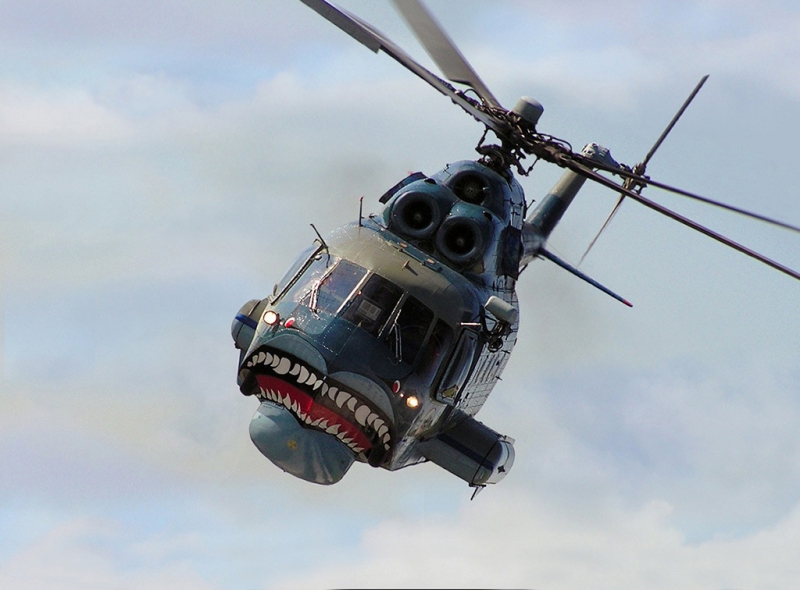
The Mi-14 could carry and nuclear depth charge "Scalp" capacity 1 CT and weight 1600 kg. This product can easily "strip" enemy submarine at a distance of up to 800 m. Provided on board and backsight bomb Omaboe. To ensure the stationary hovering when using sonar (GAS) The equipment included a system of automatic control of ACS-14, and under the tail boom placed Doppler velocity and drift angle Diss 15. The crew consisted of two pilots and a navigator-operator, the workplace that are in the cargo hold. Helicopter collected at the Moscow Helicopter Plant (in suburban punk), a boat manufactured at the Kazan Helicopter Plant, where there was a branch of OKB. In summer 1967 , the boat docked to the fuselage serial I-8 with engines TV2-117s. Since the launch of this theater that operates from battery, VSU not ustanavlivalasʹ.
The first prototype of the Mi-14 was actually a demonstration model, where no suspension arms nodes, there was no radar and other equipment, necessary to address the problems of anti. In July, the first prototype B-14, painted in the colors of Aeroflot and the registration number of the USSR - 11051, was transferred to the factory test.
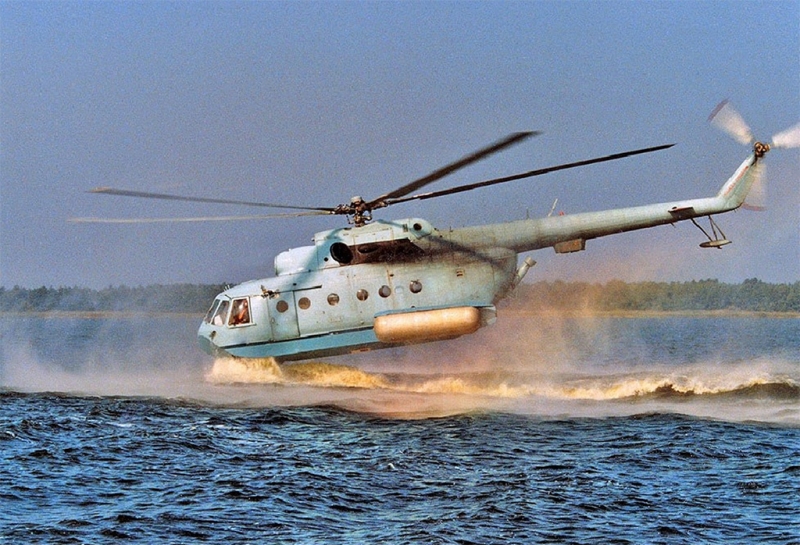
The first flight of the Mi-14, piloted by test pilot YS. Shvachko, took 1 August 1967 year from the plant site, where the machine flew on letnoispytatelnuyu EDO station Lyubertsy. When all the questions, associated with the stability and controllability of the machine, were removed, We began to fly to the "water treatment" in the southern port of the capital, omitting B-14 water by a crane. Only then we started to fly from the water surface. It happened again on the Moscow River, but away from prying eyes - in the area of the village Conversations.
At the end of the year in suburban punk began to recast the two Mi-8 (№ 0412 and number 0512) with engines TV2-117s experienced in B-14, who were to participate in the joint state tests. As with the first prototype of the amphibious helicopter, boats for them again manufactured in Kazan. Machines equipped with search and sighting systems. AT 1968 year began the main phase of the "A" Designer of the state tests, began in Lyubertsy. At this stage, again made itself felt inadequate supply of directional stability. At speeds above 180 km / h helicopter began to "walk". Such fluctuations in aviation have long been known and have been called "Dutch step". Known way of "treatment" of the disease, but the helicopter was not as such vertical fin. The solution was found, located on the "gills" keel washers, clearly visible in the photographs. The first revision made on the machine number 0412.
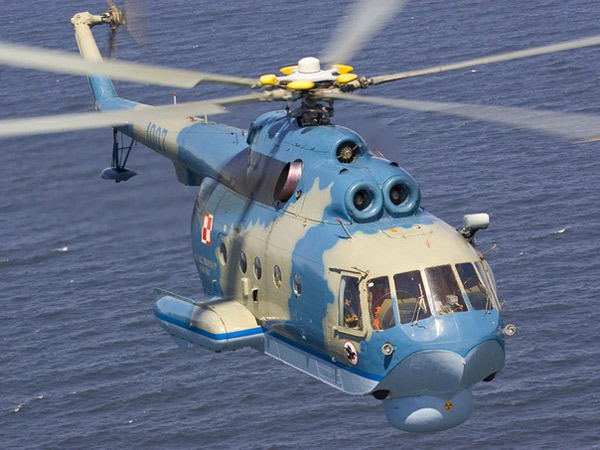
The tests in this helicopter showed insufficient stability V-14 during movement through the water, and then on the third prototype machine "gills" replaced by inflatable floats. In the retracted position floats niche closed metal caps, cowls. At the same keel washers replaced by more elegant fins. Finalized and chassis. Placing them on the dampers, rid of the oscillations of the front legs of the "shimmy", allowing the car to take off from the takeoff and landing in autorotation (city) without the threat of the destruction of the front legs. After completion of factory testing helicopter № 0412 It was to proceed with the public at Feodosiya on the airfield Kirov. The machine had to surpass its own power, but during the flight, not flying half way, due to problems in the fuel system test pilot L. Indeevu had to make an emergency. Judging by, that the B-14 sat on the mileage, it happened in autorotation. During the run of the collective farm field front-wheel drive stuck in the ground, and the helicopter rolled over. Good, that the crew survived.
After the accident in addition to the test a third prototype (№ 0512) We hooked up and the first prototype. Leading to stage "A" were PK engineers. Oleinik and VP. Komarov, pilots - OE. Efimov and YN. Iglin, navigators - RI. Subaru and RD. Yumaguzin. In trials with a three-point sea state revealed, after landing in the nose portion 14, digs into the wave, endangering the contact blades of the rotor with water, and when hovering at less than 10 m intensively splashing occurred cabin windows. At the same time it was necessary to limit the speed of the water taxi to 20 km / h because of the tendency of the machine to the burying.
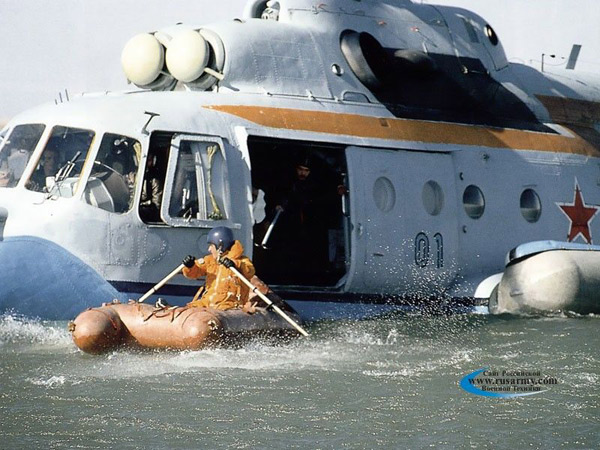
AT 1969 year test came fourth copy of the B-14, this time with regular engines TVZ-117M, and two years later the first stage of joint state tests, the results of which were granted preliminary opinion recommending the start the machine into production. Although the helicopter was given the "green light", still lacked the equipment search and targeting system, which dragged on until finishing 1974 of the year. No better than was the case with the main gear, which culminated in the test only on the eve of 1975 of the year. Nevertheless, in October 1973 the Employer proceeded to the final stage ("B") joint state tests on a machine with immature final appearance. This phase began on the prototype helicopter, but soon joined them, and the first production machine. Leading at this stage was a test pilot Air Force Institute OE. Efimov. At the final stage of testing performed in autorotation landing first airfield, and then - water, including at night. A first landing on water fulfilled test pilot MVZ GR. Karapetyan 18 October 1974 of the year. Then such landing mastered O. Efimov and B. Varakin.
Act on the results of GIS, which was also attended by pilots AD. Grishchenko (JIM), MK. Panfilov, YSD. Poluychik and AA. Timoxin, navigators AA. Danilin and VN. Parakhin, It was approved in December 1974 of the year. Two years later, in May the decision of the Central Committee of the CPSU and the USSR Council of Ministers of B-14 have adopted under the designation Mi-14PL. The first production helicopter modification became towing minesweepers Mi-14BT. To this end, in the rear part of the cargo compartment placed trawl towing device with remote control and additional portholes. Development of the machine was completed in 1973,, and 1979 he was adopted by the.
AT 1974 year search and rescue version of the Mi-14PS has been created, intended for the evacuation to 19 affected. In contrast to the anti-car doubled the doorway of the cargo compartment, We established a rescue hoist SLG-300 load-carrying capacity 300 kg, ability to lift on a cable from the grid at the same time the three affected. In the nose of the helicopter search located below the PAC and spotlights, Helicopter ten liferafts YOU 5M-3 can be lowered, vmeschayuschyh to 20 affected. Rafts with survivors can also be towed by helicopter. Mi-14PS have adopted in 1979 year.
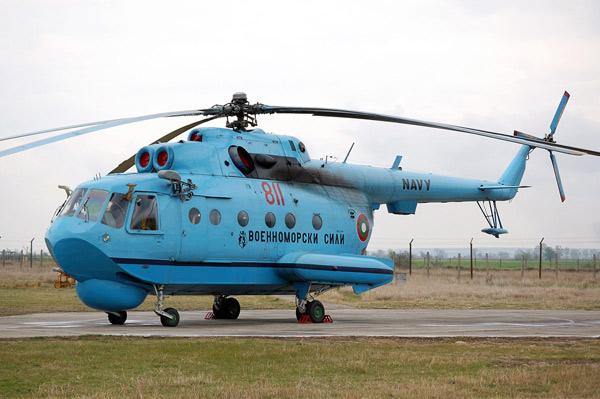
modifications
B-14 – Prototype.
Mi-14BT – Buksirovshtik minnыh trawl.
Mi-14GP – Utility version.
Mi-14p – 24-Local passenger version.
Mi-14PŽ "Eliminator" – Fire helicopter based on the Mi-14BT.
Mi-14PL – Military helicopter antisubmarine.
Mi-14PLM – Upgraded Mi-14PL.
Mi-14PLÉ – (also has the designation Mi-14E) The export version of the Mi-14PL.
Mi-14PW – Polish version of the Mi-14PL.
Mi-14PS – Search and rescue helicopter.
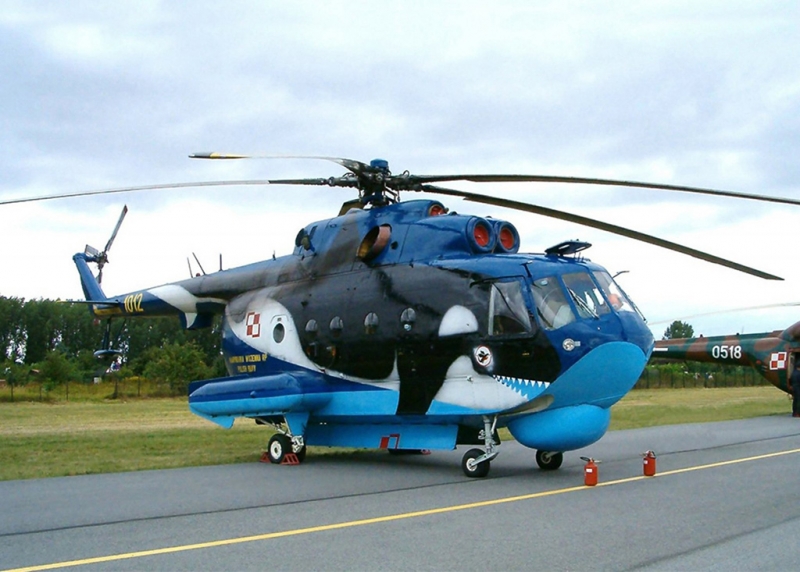
The performance characteristics of Mi-14
– Getting Started: 11 May 1976 of the year
– years of production: 1973 — 1986
– units produced: 273
Mi-14 crew
– 4 man
Overall dimensions of the Mi-14
– Length: 25,24 m
– fuselage length: 18,3 m
– The diameter of the rotor: 21,29 m
– The diameter of the tail rotor: 3.91 m
– Maximum fuselage width: 2,5 m (by floats 3,8 m)
– Height: 6,93 m
All Mi-14
– empty weight: 8900 kg
– Normal takeoff weight: 13 400 kg
– Maximum takeoff weight: 14 500 kg
– Mass fuel in internal tanks: 2500 kg
Motors Mi-14
– Power point: 2 × turboshaft "Klimov" TVZ-117M
– engine power: 2 × 2000 l. from. (in the takeoff mode)
– Engine power to emergency mode: 2 x 2200 l. from.
– Engine power at cruising: 2 x 1500 l. from.
Mi-14 speed
– full speed: 230 kmh
– Cruising speed: 210 kmh
– combat radius: 200 km
Range Mi-14 flight
– 800 km
Practical ceiling Mi-14
– 4000 m
Static ceiling of the Mi-14
– 1600 m
The armament of the Mi-14
– combat load: 2000 kg
– Bombings: 12 h 50 kg or 8 h 250 kg or 36 x sonar buoys RSL-NM "Chinar"
– torpedo: 1 x AT-1 (AT-2, T-67 "sheared", UMGT-1 'trencher', "Kolibri")
Photo Mi-14
